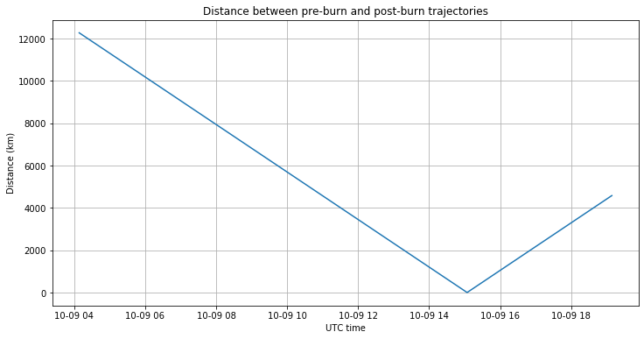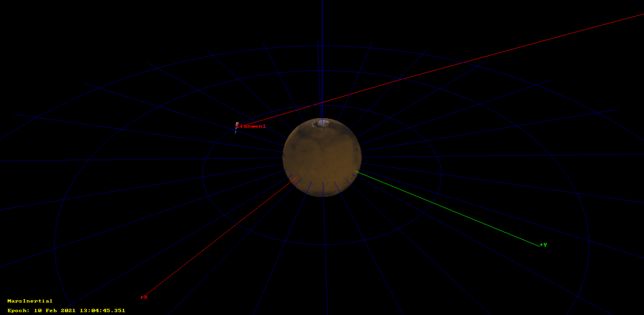As I have mentioned in several posts, the trajectory in which Tianwen-1 was launched had a closest approach to Mars of around 3 million km, so at some point a large correction manoeuvre was needed. We had already seen small manoeuvres TCM-1 and TCM-2, but we were expecting soon enough this large correction, which is called DSM (deep space manoeuvre). Some sources placed the DSM around the beginning of October, while others were more precise and mentioned that it would happen right after the Mid-Autumn festival holiday season, which this year ended on October 8.
This information turned out to be pretty accurate, since yesterday we heard news that Tianwen-1 had done its DSM at 15:00 UTC on 2020-10-09. This information quickly appeared in the news.
After the Bochum 20m antenna was able to acquire the spacecraft’s signal and gather telemetry at 19:09 UTC, we were able to confirm the manoeuvre in the state vectors transmitted by the spacecraft. Paul Marsh M0EYT was also able to receive telemetry confirming this, starting at 18:18 UTC. This post is an analysis of the data.
Since the manoeuvre happened when the spacecraft was not in view from Europe, we have no Doppler data to measure the burn directly. Thus, I have relied only on the state vectors from the telemetry, using the same method as for TCM-2. This method involves propagating forward the last state vector received before the burn and propagating backwards the first sate vector received after the burn. The intersection of the two trajectories gives the moment and delta-V of the burn.
I have used this GMAT script, which uses the following state vectors for the pre-burn and a post-burn trajectories.
Tianwen1_preTCM.Epoch = '09 Oct 2020 04:08:32.068'; Tianwen1_preTCM.X = 172471096.37504846 Tianwen1_preTCM.Y = 38882565.02362641 Tianwen1_preTCM.Z = 20338235.36580359 Tianwen1_preTCM.VX = -1.1782259639276798 Tianwen1_preTCM.VY = 26.05998493933646 Tianwen1_preTCM.VZ = 11.571927755891284 Tianwen1_postTCM.Epoch = '09 Oct 2020 19:09:40.777'; Tianwen1_postTCM.X = 172401001.66836962 Tianwen1_postTCM.Y = 40290822.63279648 Tianwen1_postTCM.Z = 20967750.693616968 Tianwen1_postTCM.VX = -1.4286845530882641 Tianwen1_postTCM.VY = 26.04901896207726 Tianwen1_postTCM.VZ = 11.853820044831242
The results of this GMAT script are processed in this Jupyter notebook. The figure below shows the distance between the pre-burn and post-burn trajectories. The point where the distance is minimal is at 15:03:59 UTC, with a distance of 556 m.

Given that this method of locating the burn approximates the burn as an impulsive burn, it makes sense that it will actually locate the midpoint of the burn. The media quote a burn length of 480 seconds (8 minutes) at 15:00 UTC, so the fact that my study locates the burn at 15:04 UTC seems about right.
The delta-V vector in ICRF coordinates and m/s is
-31.49477234, 39.29765307, 308.11690616
The magnitude of this vector is 312.2 m/s. The engine is said to have a force of 3kN, and the mass of the spacecraft is around 5000kg. Applying this force to this mass for 480 seconds produces a delta-V of 288 m/s. This doesn’t take into account the mass of the fuel spent during the burn (which we don’t know how much was), which would make the produced delta-V somewhat higher. Therefore, the delta-V measured from the state vectors seems to match the data in the press release.
Something interesting is that the angle between this delta-V vector and the delta-V vector from TCM-2 is only 2.8 degrees. This makes me think that both burns happened in exactly the same direction, and that TCM-2 was some kind of test for this large burn. In fact, TCM-2 was also done at 15:00 UTC. Recall that TCM-2 was a short burn of four 120N thrusters for 20 seconds.
After propagating the new trajectory in GMAT all the way to Mars, we see that the new trajectory is in fact quite adequate for Mars orbit injection. The periapsis altitude is around 18000km (give or take 1000km, since it is quite sensitive to the parameters of the propagator, so it is difficult to estimate accurately).

Still, two or three small corrections remain until arrival to Mars around 2021-02-10, to account for all the possible perturbations in the transfer orbit.
It is convenient to remark that the state vector data we are using in this post most likely comes from a prediction done before the burn and doesn’t reflect the actual performance of the burn. In a few days we will most likely see a small change in the trajectory described by the state vectors as the Chinese DSN performs ranging to determine the new trajectory accurately and uploads the data to the spacecraft. We have already seen something like this for TCM-1 and for TCM-2.
Congratulations to the Tianwen-1 team and China National Space Administration for their successful mission, and thanks to the AMSAT-DL people at Bochum and to Paul Marsh for their continuous effort in tracking this mission.
Hello!
I have also tracked Tianwen-1 yesterday evening. Initially I did not see any signal from the spacecraft at all. Perhaps it was using low gain antenna during TCM? The signal appeared at 16:33:53 starting with a few seconds of unmodulated subcarriers. After that normal low speed telemetry was transmitted following high speed telemetry session later. I have captured the waterfall at start of transmission: http://gs1.to.ee/public_to117/Obs/Viljo/dsn/tianwen/20201009_001.JPG .
Decoded data for last night pass is available here:
http://gs1.to.ee/public_to117/Obs/Viljo/dsn/tianwen/decoded/.
I did record also part of the HS transmission, I can make I/Q data files available online if there is some interest. Not sure if the SNR was good enough for decoding. At least when I tried with decoder I saw QPSK constellation, but not all the time.
73,
Viljo ES5PC
Thanks Viljo!
It is to be expected that the spacecraft used the low gain antenna during the burn, since the high-gain antenna was not appropriately oriented to point to Earth. It is a bit surprising that the signal from the high gain antenna came back 1 hour and 30 minutes after the burn (it seems like a long time).
That data is quite interesting, since it’s a couple hours earlier than what we have from Paul (it helps that Estonia is more Eastern than the UK or Germany).
The high speed transmission can be specially interesting, because it is possible that they replayed some of the telemetry recorded during the burn. We don’t have that data through Bochum or Paul, so I would be interested in taking a look at the IQ recordings. I can try to optimize the decoder if the SNR is not so good.
Best,
Dani.
I have now checked the HS recordings from yesterday and it looks like spacecraft was back to low speed when I started recording.
I did not have any spectrum monitoring active when recording so I was not able to spot that during recording. I’m sorry about that.
Viljo
No problem, don’t worry, and thanks for your support!
Well, as far as I know, the TW-1’s main maneuver engine( they called it as the YF-37) has an vacuum Isp at 321.6s, this data may be helpful for you to calculate the ΔV 🙂
Thanks! That’s interesting, and also a fairly typical Isp for this kind of engine. Using that Isp and a force of 3kN, I get a mass flow rate of 0.95kg/s. Thus, during the 480 seconds burn, 456.9kg of fuel would have been spent. Plugging this into the rocket equation, and assuming an initial mass of 5000kg, I get a delta-V of 302m/s, which is much closer to the 312m/s I calculated from the state vectors.